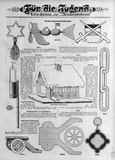‘We’ll hold out’: The Functions and Applications of Children’s and Teenage Literature in the First World War
As far back as 1774, Empress Maria Theresa had declared in her decree on school reform that ‘the education of youth of both sexes (...) [was] the most important fundament for the true happiness of nations.’ One of the approved teaching methods was the targeted educational use of children’s and teenage literature. Austria and Germany were particularly productive in this field, with Nuremberg and Vienna being the most important centres of publishing. It was inevitable, then, that war propaganda would extend its reach to literature for young people.
publications carry clear ideological messages. In this respect, Peter Lukasch identifies the following central functions: depictions of children in various publications were designed to arouse reader empathy and make it easier to spread propaganda messages and jingoistic statements, or to demonize the ‘enemy’ for an adult audience. For this reason, war postcards frequently showed children playing war-games and wearing uniform.
The primary purpose of war literature for (younger) children was not to convince them of the legitimacy and necessity of war. It was, rather, the adults who were reading to and with the children who could be reached through these books, using simple, bold texts and images. The war picture-book was a phenomenon of the First World War, and was not used as frequently during the National Socialist period.
Older children were a direct target group for propaganda literature. They were to be prepared for joining up, and persuaded to make their contribution to the war effort – just as Else Ury, for example, in Nesthäkchen im Weltkrieg [Nesthäkchen in the World War] describes in detail. Depictions of everyday life during wartime are presented from many angles in children’s novels; always, of course, with patriotic overtones. These often include astonishingly dramatic and honest descriptions of the front. Another function of these narratives, according to Hans-Heino Ewers, was to act out the fears of adults through the medium of their child protagonists.
Over the years, the tone and content of children’s and teenage literature evolved. Now, the reader was faced with rallying cries to persevere, incitements to self-sacrifice and calls to accept the hardships of war.
Translation: Aimee Linekar
Dahrendorf, Malte: Jugendliteratur und Politik. Gesellschaftliche Aspekte der Kinder- und Jugendliteratur, Frankfurt am Main 1986
Ewers, Hans-Heino: Erfahrung schrieb's und reicht's der Jugend: Geschichte der deutschen Kinder- und Jugendliteratur vom 18. bis zum 20. Jahrhundert [Kinder- und Jugendkultur, -literatur und -medien. Theorie – Geschichte – Didaktik, Band 68], Frankfurt am Main 2010
Lukasch, Peter: Der muss haben ein Gewehr: Krieg, Militarismus und patriotische Erziehung in Kindermedien vom 18. Jhdt. bis in die Gegenwart, Norderstedt 2012
Quotes:
„the education of youth ...": Allgemeine Schulordnung 1774, Vorrede "Beweggründe zur Festsetzung einer allgemeinen Landschulordnung" (Translation)




